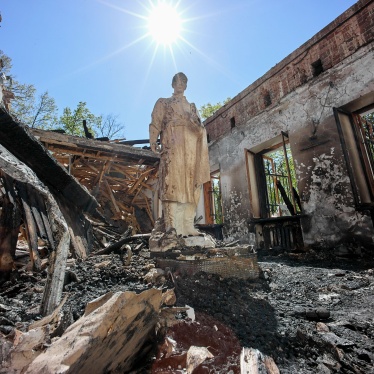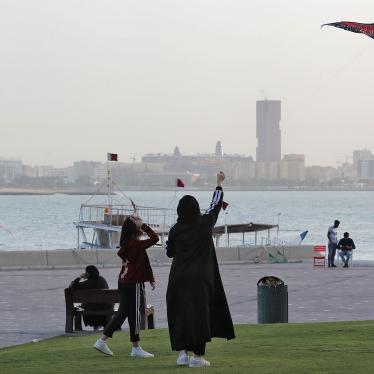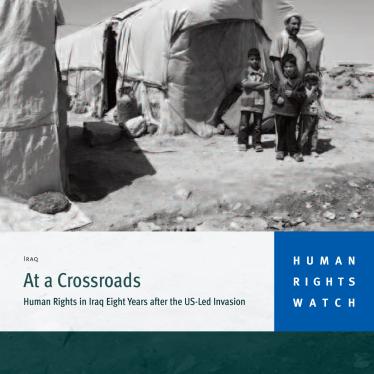(Geneva) – The Syrian government is still using cluster munitions in its conflict even as nations that have joined the treaty banning the weapons are rapidly destroying their stockpiles, Human Rights Watch said today at the release of Cluster Munition Monitor 2013, a global report reviewing adherence to the Convention on Cluster Munitions.
“Syria is persisting in using cluster bombs, insidious weapons that remain on the ground, causing death and destruction for decades,” said Mary Wareham, Arms Division advocacy director at Human Rights Watch and a final editor of the report. “Meanwhile, other countries around the world that have joined the treaty are showing a strong commitment to get rid of cluster bombs once and for all.”
Cluster Munition Monitor 2013 is the annual report of the Cluster Munition Coalition, which Human Rights Watch co-founded. The report was issued in advance of the convention’s Fourth Meeting of States Parties, which opens in Lusaka, Zambia on September 9. Human Rights Watch leads the Cluster Munition Coalition’s monitoring of adherence to the treaty’s provisions banning the use, production, trade, and stockpiling of cluster munitions.
Cluster munitions have been banned because of their widespread indiscriminate effect at the time of use, and the long-lasting danger they pose to civilians. Cluster munitions can be fired by artillery and rocket systems or dropped by aircraft, and typically explode in the air and send dozens, even hundreds, of tiny bomblets over an area the size of a football field. Cluster submunitions often fail to explode on initial impact, leaving duds that act like landmines.
A total of 112 countries have signed or acceded to the 2008 Convention on Cluster Munitions, which prohibits the use, production, transfer, and stockpiling of cluster munitions, and requires the clearance of cluster munition remnants within 10 years as well as assistance for victims of the weapons. Of these countries, 83 are states parties legally bound to carry out all of the convention’s provisions, while the other 29 have signed but not yet ratified the convention.
According to Cluster Munition Monitor 2013, states parties have so far destroyed a total of1.03 million stockpiled cluster munitions containing nearly 122 million submunitions. This is 71 percent of the cluster munitions and 69 percent of submunitions declared as stockpiled by the treaty’s states parties. In 2012 alone, 173,973 cluster munitions and 27 million submunitions were destroyed by Denmark, France, Germany, Italy, the Netherlands, the United Kingdom, and other states parties. In 2011, 107,000 cluster munitions and 17.6 million submunitions were destroyed under the convention.
“Nations that have yet to join the convention should recognize its crucial role as the only effective way to rid the world of the curse of cluster munitions,” Wareham said. “It’s not enough to feel bad about civilian casualties caused by cluster munitions. To prevent future use of cluster munitions all nations need to join the convention without delay.”
Most of the 29 countries that have signed but not yet ratified the Convention on Cluster Munitions are in the process of ratifying and already carrying out its provisions. There has been less progress in bringing new countries on board. Since the treaty entered into force on August 1, 2010, countries may no longer sign, but must join via a process known as accession. Only four nations have done so: Andorra on April 9, 2013, and Grenada, Swaziland, and Trinidad and Tobago in 2011.
Most of the 80 non-signatories are adhering to the provisions of the Convention on Cluster Munitions even if they have not acceded, but problems remain, Human Rights Watch said. In addition to Syria, since 2010, cluster munitions have been used by Libya under its former leader, Muammar Gaddafi, and by Thailand, with unconfirmed reports of use by Burma and Sudan. None of these countries have joined the treaty.
In Syria, Human Rights Watch identified 152 separate locations where government forces used at least 204 cluster munitions from July 2012 until June 2013, in 9 of the country’s 14 governorates. Several locations have been repeatedly attacked with cluster munitions. This data provides only an incomplete picture, however, as not all remnants have been recorded on video or by other means. The actual number of cluster munitions used by Syrian government forces is probably higher, Human Rights Watch said.
Syria’s cluster munition use has attracted widespread media coverage and public outcry. The Convention on Cluster Munitions requires each state party to “make its best efforts to discourage States not party … from using cluster munitions.” A total of 113 countries have condemned Syria’s use of cluster munitions, including more than three-dozen non-signatories. Most condemned the use through a UN General Assembly resolution, while several foreign ministers have repeatedly expressed concern about the use of cluster munitions in Syria.
Following apparent chemical weapons attacks on August 21, 2013, in Eastern and Western Ghouta near Damascus, the United States and other countries are assessing options for military intervention in Syria. The last reported US use of a cluster munition was in Yemen on December 17, 2009, when one or more TLAM-D cruise missiles loaded with BLU-97 bomblets struck the hamlet of al-Majala in southern Abyan province, causing more than 40 civilian casualties. The US should not use cluster munitions in a possible intervention in Syria, said Human Rights Watch.
“Syria’s extensive cluster munition use is casting a somber shadow over the real progress that the convention is making to put an end to the human suffering that these weapons cause,” Wareham said. “Any US use of cluster munitions in Syria would only make the humanitarian crisis worse. It is crucial that all countries stigmatize cluster munitions by affirming these weapons should never be used.”






